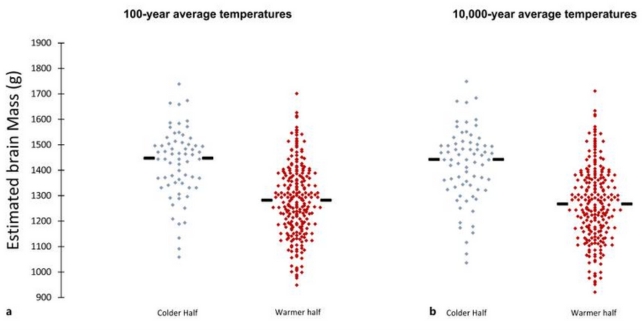A new study suggests a link between past climate changes and a drop in the size of the human brain – an adaptive response that emerges in an analysis of climate records and human remains over a 50,000-year period.
The research by cognitive scientist Jeff Morgan Stibel from the Natural History Museum in California adds to our understanding of how humans develop and adapt in response to environmental stress.
"Given recent global warming trends, it is critical to understand the impact of climate change, if any, on human brain size and ultimately human behavior." Stibel writes in his published paper.
The study looked at how the brain size of 298 Homo specimens changed over the last 50,000 years in relation to natural records of global temperature, humidity, and rainfall. When the climate got warmer, the average brain size grew significantly smaller than when it was cooler.
Stibel's prior research on brain shrinkage prompted this investigation because he wanted to understand its root causes.
"Understanding how the brain has changed over time in hominins is critical but very little work has been done on this subject," Stibel told PsyPost's Mane Kara-Yakoubian.
"We know the brain has grown across species over the past few million years but we know very little about other macroevolutionary trends."
Stibel obtained data on skull sizes from ten separate published sources, for a total of 373 measurements from 298 human bones spanning 50,000 years. He included body size estimations that were adjusted for geographical region and gender to estimate brain sizes.
The fossils were put into groups based on how long ago they lived, and Stibel conducted his research using four different fossil age spans of 100 years, 5,000 years, 10,000 years, and 15,000 years to help account for dating errors.
Then he compared brain size to four climate records, including temperature data from European Project for Ice Coring in Antarctica (EPICA) Dome C. The ice core at EPICA Dome C gives accurate measurements of the surface temperature going back more than 800,000 years.
In the last 50,000 years, there's been the Last Glacial Maximum, which caused average temperatures to be consistently colder until the end of the Late Pleistocene. The Holocene then saw average temperatures rise, bringing us to the present day.

The analysis showed a general pattern of changing brain size in Homo, which is correlated with climate change as temperatures rise and fall. Humans had a considerable decline in average brain size, amounting to just over 10.7 percent, throughout the Holocene warming period.
"Brain size changes appear to take place thousands of years after changes to climate, and this is particularly pronounced after the last glacial maximum, approximately 17,000 years," Stibel explains in his paper.
"While [acclimatization] unfolds within a single generation and natural selection can happen in as short as a few successive generations, species level adaptation often takes many successive generations."
This evolutionary pattern happened over a relatively brief period of time, ranging from 5,000 to 17,000 years, and the trends suggest that ongoing global warming could have detrimental effects on human cognition.
"Even a slight reduction in brain size across extant humans could materially impact our physiology in a manner that is not fully understood," argues Stibel in his paper.
The analysis showed that humidity and rainfall levels also had an effect on brain growth. While temperature is a more significant factor, it did find a weak correlation between dry spells and slightly larger brain volumes.
There are still questions about what exactly causes variations in Homo brain size. The results show that climate change is related to differences in brain size, but climate doesn't seem to account for all of the evolutionary variation.
According to Stibel, ecosystem factors like predation, indirect climate effects like vegetation and net primary production, or non-climate factors like culture and technology could all be contributing to changes in brain size.
"The results suggest that climate change is predictive of Homo brain size, and certain evolutionary changes to the brain may be a response to environmental stress," Stibel concludes.
"More work will be needed to determine whether the impact of climate change on Homo physiology is a result specifically of temperature changes or an indirect effect from other elements of a changing environment."
The study has been published in Brain, Behavior and Evolution.
